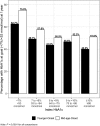Initial Glycemic Control and Care Among Younger Adults Diagnosed With Type 2 Diabetes
- PMID: 32132007
- PMCID: PMC7171948
- DOI: 10.2337/dc19-1380
Initial Glycemic Control and Care Among Younger Adults Diagnosed With Type 2 Diabetes
Abstract
Objective: The prevalence of type 2 diabetes is increasing among adults under age 45. Onset of type 2 diabetes at a younger age increases an individual's risk for diabetes-related complications. Given the lasting benefits conferred by early glycemic control, we compared glycemic control and initial care between adults with younger onset (21-44 years) and mid-age onset (45-64 years) of type 2 diabetes.
Research design and methods: Using data from a large, integrated health care system, we identified 32,137 adults (aged 21-64 years) with incident diabetes (first HbA1c ≥6.5% [≥48 mmol/mol]). We excluded anyone with evidence of prior type 2 diabetes, gestational diabetes mellitus, or type 1 diabetes. We used generalized linear mixed models, adjusting for demographic and clinical variables, to examine differences in glycemic control and care at 1 year.
Results: Of identified individuals, 26.4% had younger-onset and 73.6% had mid-age-onset type 2 diabetes. Adults with younger onset had higher initial mean HbA1c values (8.9% [74 mmol/mol]) than adults with onset in mid-age (8.4% [68 mmol/mol]) (P < 0.0001) and lower odds of achieving an HbA1c <7% (<53 mmol/mol) 1 year after the diagnosis (adjusted odds ratio [aOR] 0.70 [95% CI 0.66-0.74]), even after accounting for HbA1c at diagnosis. Adults with younger onset had lower odds of in-person primary care contact (aOR 0.82 [95% CI 0.76-0.89]) than those with onset during mid-age, but they did not differ in telephone contact (1.05 [0.99-1.10]). Adults with younger onset had higher odds of starting metformin (aOR 1.20 [95% CI 1.12-1.29]) but lower odds of adhering to that medication (0.74 [0.69-0.80]).
Conclusions: Adults with onset of type 2 diabetes at a younger age were less likely to achieve glycemic control at 1 year following diagnosis, suggesting the need for tailored care approaches to improve outcomes for this high-risk patient population.
© 2020 by the American Diabetes Association.
Conflict of interest statement
This article is featured in a podcast available at https://www.diabetesjournals.org/content/diabetes-core-update-podcasts.
Figures


Similar articles
-
The Legacy Effect in Type 2 Diabetes: Impact of Early Glycemic Control on Future Complications (The Diabetes & Aging Study).Diabetes Care. 2019 Mar;42(3):416-426. doi: 10.2337/dc17-1144. Epub 2018 Aug 13. Diabetes Care. 2019. PMID: 30104301 Free PMC article.
-
Inequalities in glycemic control in childhood onset type 2 diabetes in England and Wales-A national population-based longitudinal study.Pediatr Diabetes. 2019 Nov;20(7):821-831. doi: 10.1111/pedi.12897. Epub 2019 Jul 29. Pediatr Diabetes. 2019. PMID: 31329349
-
Age at type 2 diabetes onset and glycaemic control: results from the National Health and Nutrition Examination Survey (NHANES) 2005-2010.Diabetologia. 2013 Dec;56(12):2593-600. doi: 10.1007/s00125-013-3036-4. Epub 2013 Sep 1. Diabetologia. 2013. PMID: 23995472 Free PMC article.
-
Improvement of glycemic control in type 2 diabetes: A systematic review and meta-analysis of randomized controlled trials.Nutr Metab Cardiovasc Dis. 2021 Aug 26;31(9):2539-2546. doi: 10.1016/j.numecd.2021.05.010. Epub 2021 May 24. Nutr Metab Cardiovasc Dis. 2021. PMID: 34158243
-
Current insights and emerging trends in early-onset type 2 diabetes.Lancet Diabetes Endocrinol. 2023 Oct;11(10):768-782. doi: 10.1016/S2213-8587(23)00225-5. Epub 2023 Sep 11. Lancet Diabetes Endocrinol. 2023. PMID: 37708901 Review.
Cited by
-
Racial and Ethnic Differences in Medication Initiation Among Adults Newly Diagnosed with Type 2 Diabetes.J Gen Intern Med. 2023 Mar;38(4):994-1000. doi: 10.1007/s11606-022-07746-4. Epub 2022 Aug 4. J Gen Intern Med. 2023. PMID: 35927604 Free PMC article.
-
The Burden of Type 2 Diabetes in Adolescents and Young Adults in China: A Secondary Analysis from the Global Burden of Disease Study 2021.Health Data Sci. 2024 Dec 17;4:0210. doi: 10.34133/hds.0210. eCollection 2024. Health Data Sci. 2024. PMID: 39691606 Free PMC article.
-
Impact of Sex and Metabolic Comorbidities on Coronavirus Disease 2019 (COVID-19) Mortality Risk Across Age Groups: 66 646 Inpatients Across 613 U.S. Hospitals.Clin Infect Dis. 2021 Dec 6;73(11):e4113-e4123. doi: 10.1093/cid/ciaa1787. Clin Infect Dis. 2021. PMID: 33337474 Free PMC article.
-
Greater Glycemic Burden Is Associated with Further Poorer Glycemic Control in Newly-Diagnosed Type 2 Diabetes Mellitus Patients.Nutrients. 2022 Jan 13;14(2):320. doi: 10.3390/nu14020320. Nutrients. 2022. PMID: 35057503 Free PMC article.
-
The effect of comorbidities on glycemic control among Colombian adults with diabetes mellitus: a longitudinal approach with real-world data.BMC Endocr Disord. 2021 Jun 26;21(1):128. doi: 10.1186/s12902-021-00791-w. BMC Endocr Disord. 2021. PMID: 34174843 Free PMC article.
References
-
- Centers for Disease Control and Prevention United States Diabetes Surveillance System: diagnosed diabetes [Internet]. Available from https://gis.cdc.gov/grasp/diabetes/DiabetesAtlas.html. Accessed 22 October 2019.
-
- Hillier TA, Pedula KL. Complications in young adults with early-onset type 2 diabetes: losing the relative protection of youth. Diabetes Care 2003;26:2999–3005 - PubMed
-
- Eppens MC, Craig ME, Cusumano J, et al. . Prevalence of diabetes complications in adolescents with type 2 compared with type 1 diabetes. Diabetes Care 2006;29:1300–1306 - PubMed
Publication types
MeSH terms
Substances
Grants and funding
LinkOut - more resources
Full Text Sources
Medical
Miscellaneous

